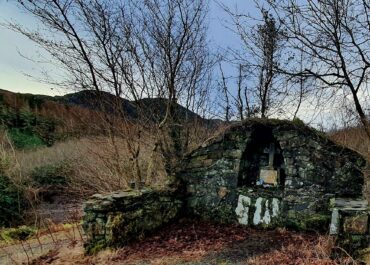Church, Leathchoill, Co. Donegal
In the pastoral lands west of the Murlin River in County Donegal stands a modest stone ruin that locals know as Teampall a' Manaigh, or the monks' church.
Church, Leathchoill, Co. Donegal
This rectangular structure, measuring roughly 6.6 metres east to west and 4.4 metres north to south externally, represents centuries of religious heritage in rural Ireland. Its walls, though now standing only about 1.5 metres at their highest point, showcase traditional building techniques with stone slabs forming the outer faces and smaller rubble filling the core, all bound together with distinctive yellow sea-sand mortar. The way the wall corners meet suggests the building was constructed in phases rather than all at once, with the junctions only partially interlocked.
Just five metres north of the church lies a small, flat-topped oval cairn that tradition holds to be a monk’s burial place. This modest mound, measuring about 7.75 metres by 4.4 metres and rising less than half a metre high, adds to the sacred character of the site. Together, these structures paint a picture of early Christian monastic life in Donegal, where small communities of religious men established simple churches and lived out their devotions in relative isolation.
The site may have once held additional religious monuments; Michael Herity’s 1971 survey mentions a lost stone cross from nearby Royard that belonged to this vicinity, though no trace of it has been found in recent decades. Today, the ruins sit quietly on their southeast-facing slope, surrounded by decent grazing land, offering visitors a tangible connection to Ireland’s early Christian heritage. The archaeological record for this site comes primarily from the comprehensive 1983 Archaeological Survey of County Donegal, which documented these and hundreds of other historical sites across the county.


